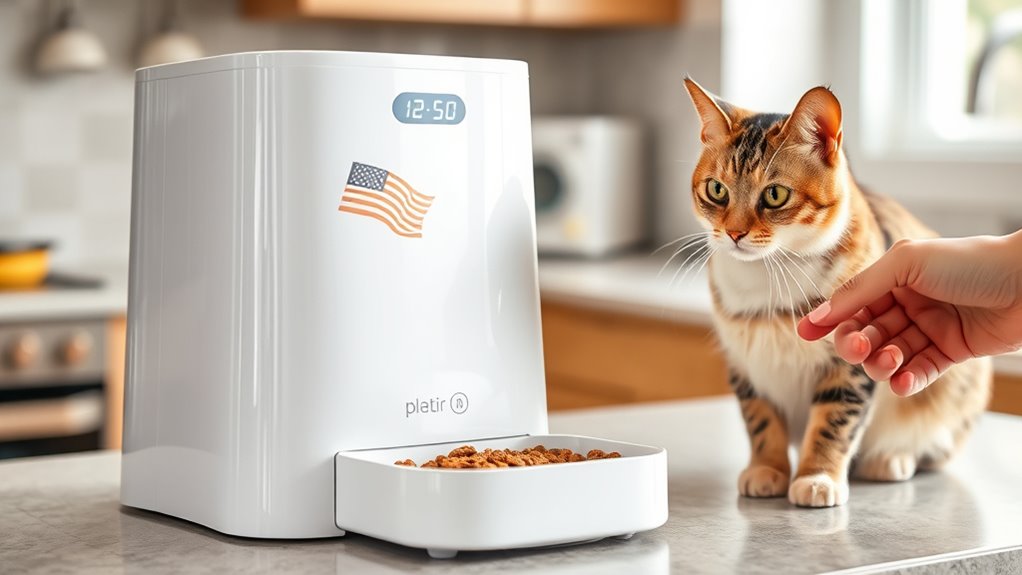Automatic pet feeders help you stay on schedule and reduce stress by ensuring your pet gets meals on time, even when you’re busy or away. They offer convenient programming, portion control, and remote access, but can sometimes malfunction or require regular maintenance. Costs vary based on features, and technical issues like software glitches or power failures may occur. Curious about how to maximize benefits and avoid pitfalls? Keep exploring for more useful insights.
Key Takeaways
- They offer convenient scheduling and remote control, ensuring pets are fed on time regardless of owner location.
- Precise portion control promotes pet health and reduces food waste, supporting dietary needs.
- Mechanical and electronic components may wear out or malfunction, requiring regular maintenance and troubleshooting.
- Power outages and software glitches can disrupt feeding routines, necessitating backup solutions and updates.
- Higher-end models can be costly, but long-term savings and health benefits may outweigh initial expenses.
Convenience and Scheduling Benefits
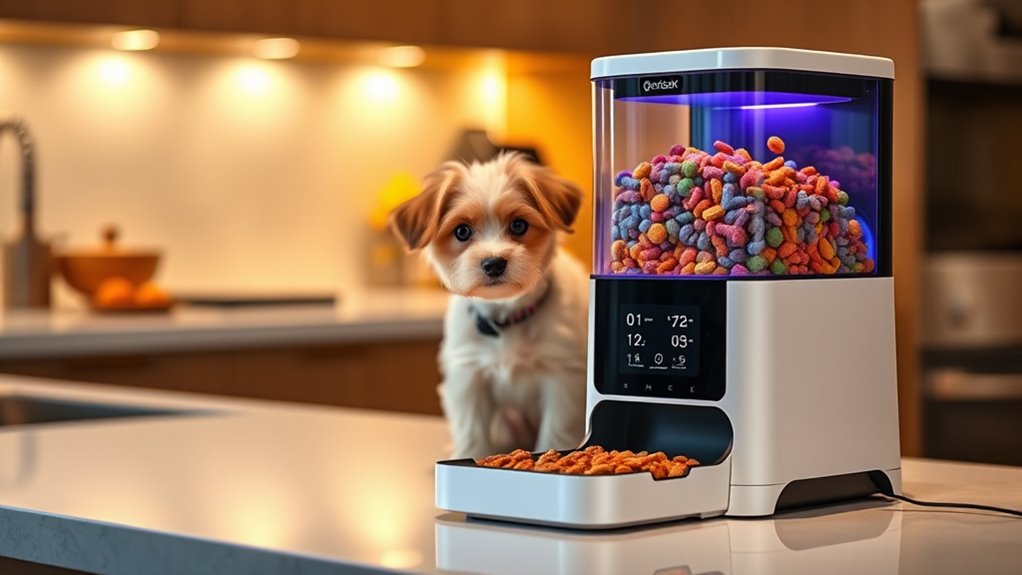
Automatic pet feeders offer unmatched convenience by allowing you to set precise feeding times without needing to be home. You gain incredible feeding schedule flexibility, ensuring your pets are fed on time, even when your day gets busy. Many models feature a user interface simplicity that makes programming quick and straightforward, so you won’t struggle with complicated menus or confusing controls. This ease of use means you can customize feeding times with minimal effort, providing peace of mind and reducing the stress of managing your pet’s diet. Additionally, understanding feeding schedules helps you better coordinate your pet’s care routine, which can contribute to their overall health. Whether you’re at work, running errands, or traveling, these feeders help maintain a consistent routine. Overall, they make pet care more manageable, saving you time while ensuring your furry friends stay well-fed and happy.
Portion Control and Dietary Management
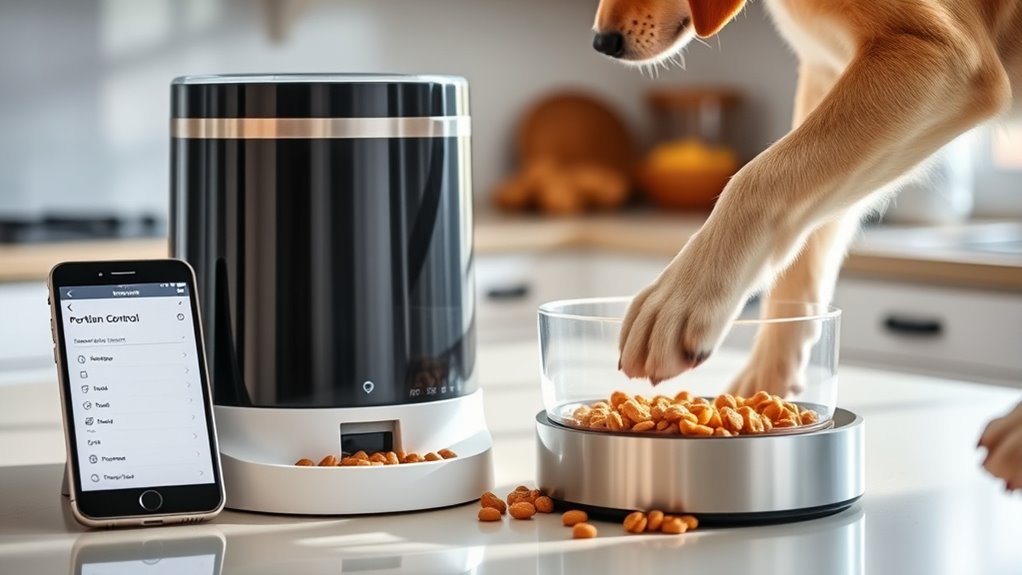
Effective portion control is essential for maintaining your pet’s health and preventing overfeeding. Automatic feeders help you achieve dietary consistency by delivering precise portions each mealtime, ensuring your pet receives the right amount of food daily. With portion accuracy, you reduce the risk of obesity and related health issues. Many models allow you to set specific portion sizes, making it easier to stick to your veterinarian’s dietary recommendations. Consistent feeding schedules combined with accurate portions support better digestion and overall well-being. By managing portions carefully, you also minimize waste and mess. Ultimately, automatic feeders give you the tools to maintain a balanced diet for your pet, promoting health and longevity through reliable dietary management.
Accessibility for Busy Pet Owners
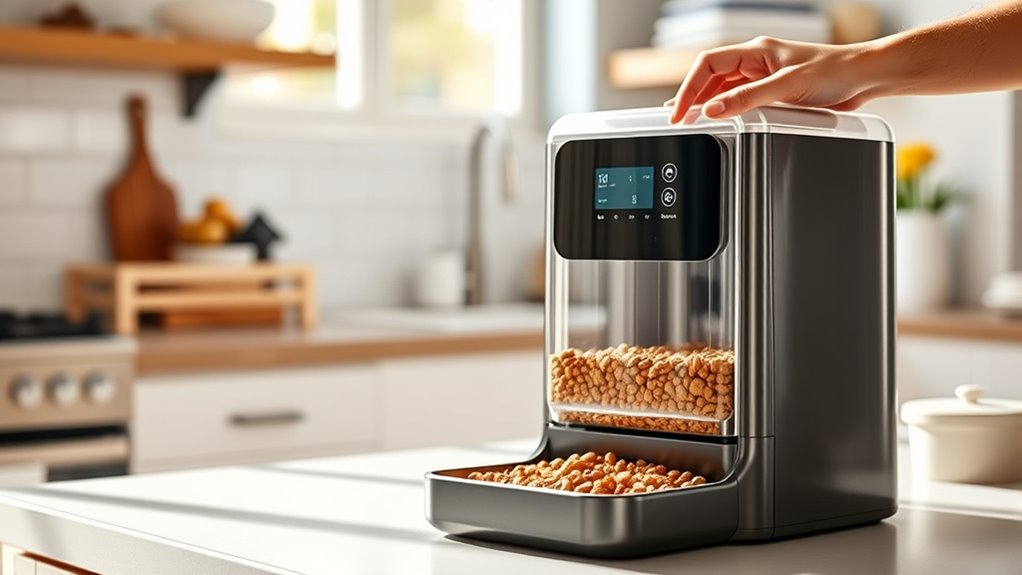
As a busy pet owner, you need a feeder that fits your schedule, so easy scheduling options are crucial. Remote feeding lets you check and dispense food from anywhere, saving you time and hassle. These features make caring for your pet more convenient and ensure they’re fed on time, even when you’re busy. Additionally, many automatic feeders incorporate privacy and cookie usage measures to enhance user experience and security. Implementing secure payment processing features further ensures your financial information remains protected during transactions. Incorporating smart technology can also provide real-time alerts and updates about your pet’s feeding status, offering peace of mind.
Easy Scheduling Options
For busy pet owners, having easy scheduling options is essential to make certain their pets are fed on time without hassle. Whether your pet is small or large, automatic feeders let you set precise feeding times based on pet size and feeding frequency. This prevents overfeeding or underfeeding, especially if your schedule varies. Many feeders offer customizable schedules, so you can program multiple feedings daily or weekly. Here’s a quick look:
| Pet Size | Feeding Frequency |
|---|---|
| Small pets | Multiple small meals per day |
| Large pets | Fewer, larger meals at set times |
| Medium pets | Balanced schedule for consistent intake |
These options give you peace of mind, knowing your pet’s diet stays consistent regardless of your busy day. Regulatory standards in the industry help ensure these devices operate safely and effectively. Additionally, some advanced feeders incorporate smart technology for remote monitoring and control, further simplifying pet care. Implementing proper storage of pet food in conjunction with automatic feeding can help maintain freshness and prevent spoilage. Moreover, integrating electric-powered feeders can provide reliable operation even during power outages.
Remote Feeding Convenience
With remote feeding features, you can easily dispense food for your pet from anywhere, making it easier to stick to their schedule even when you’re away or caught up in other tasks. This convenience helps maintain your pet owner routines without the need to be physically present at mealtime. Whether you’re at work, running errands, or traveling, you can guarantee your pet receives their meal on time, supporting feeding schedule consistency. The ability to control feeding remotely reduces stress and worry about missed feedings or delays. It also allows you to adapt to unexpected changes in your day while keeping your pet’s nutrition on track. Additionally, remote feeding can help monitor your pet’s feeding habits to ensure they are eating properly, which can be beneficial for their health. Incorporating home decor elements like wall organization systems can help keep your pet’s feeding area neat and accessible. Modern automation technology enhances the overall convenience of remote feeding systems, making pet care more seamless. Moreover, integrating water management techniques can help ensure your pet stays hydrated, complementing their feeding routine. Overall, remote feeding makes caring for your pet more flexible and reliable, especially for busy pet owners juggling multiple commitments.
Time-Saving Benefits
Busy pet owners often find that automatic pet feeders save valuable time by streamlining feeding routines. With these devices, you gain feeding schedule flexibility, allowing you to set multiple meals at precise times without extra effort. Envision a system that automatically dispenses food, freeing you from constant monitoring. This saved time can be dedicated to pet bonding opportunities, like playing or cuddling, instead of worrying about feeding delays. Imagine this:
| Time of Day | Meal Type |
|---|---|
| Morning | Breakfast |
| Noon | Midday Snack |
| Afternoon | Afternoon Meal |
| Evening | Dinner |
| Night | Late Snack (optional) |
This setup simplifies your day, ensures your pet’s needs are met, and reduces stress for both of you. Color accuracy also plays a role in how appealing and engaging your pet’s food display appears, especially if visual cues are important for your pet’s eating habits. Additionally, understanding the features of automatic feeders, such as portion control and timer settings, can help optimize your pet’s nutrition and health. Incorporating Mazda Tuning techniques like aesthetic enhancements and feature upgrades can also inspire ideas for customizing your pet feeder’s design and functionality to better suit your needs.
Furthermore, considering Kia Tuning options for aesthetic modifications can help you personalize the look of your pet feeder, making it a stylish addition to your home.
Potential Technical Issues and Malfunctions
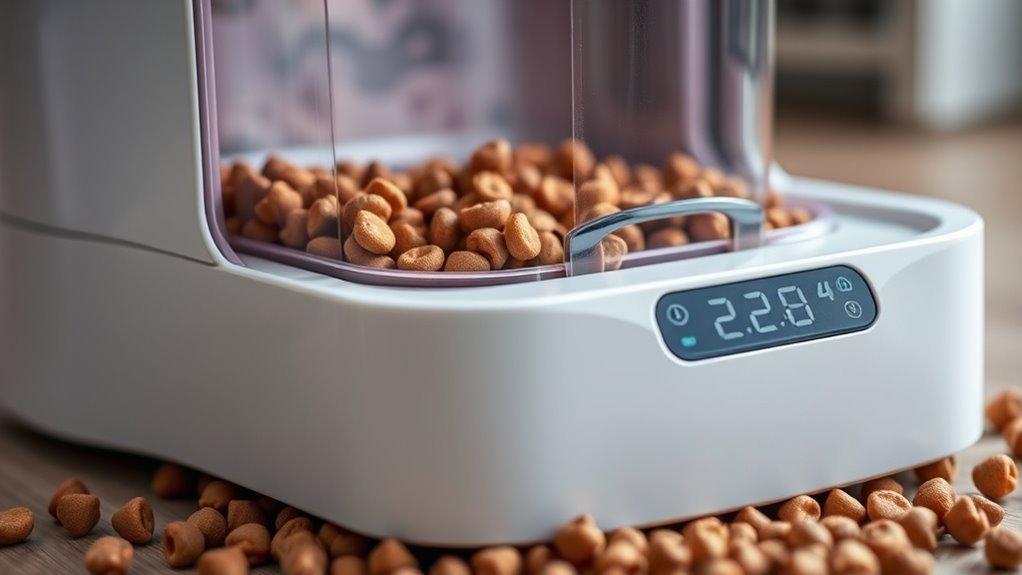
Power outages can leave your pet hungry if the feeder relies on electricity. Mechanical parts might break down over time, causing feeding delays or failures. Software glitches can also trigger errors, disrupting the feeding schedule unexpectedly. Additionally, remote management features may be vulnerable to cybersecurity risks, which could compromise your pet’s feeding routine. Regular maintenance and updates can help mitigate some of these issues, but users should remain vigilant about technology vulnerabilities that impact smart devices. Unexpected power surges may also damage electronic components, leading to malfunctions. Ensuring proper electrical protection can reduce the risk of damage from such surges.
Power Outages Disrupt Feeding
When a power outage occurs, automatic pet feeders can suddenly stop functioning, leaving your pet without access to their scheduled meals. Without a power source, your feeder might not dispense food, especially if it lacks a battery backup. Power surges can also damage the internal electronics, causing malfunctions. To minimize issues, consider models with a battery backup option, ensuring your pet’s meals are unaffected during outages. Prevent damage from power surges by installing surge protectors. Additionally, selecting a vetted home theatre projector can help ensure reliable performance during power fluctuations. As automation becomes more prevalent, understanding and mitigating data privacy challenges associated with smart devices is increasingly important. Being aware of electrical safety measures can further protect your devices and home during unexpected outages. Incorporating backup power solutions such as generators or UPS systems can provide added security for your automated devices during extended outages.
Mechanical Part Failures Occur
Mechanical components in automatic pet feeders, such as motors, gears, and dispensers, are susceptible to wear and tear over time. This can lead to malfunctions or complete failures, especially if hardware durability isn’t high. When parts degrade or break, your feeder might stop dispensing food correctly or jam altogether. Regular use accelerates component deterioration, making it necessary to contemplate component replacement to keep the device functioning properly. If you notice feeding issues, inspect the mechanical parts first; often, fixing or replacing worn components resolves the problem. Relying on durable hardware can extend the lifespan of your feeder and reduce unexpected breakdowns. However, even well-made units can experience mechanical failures, so staying attentive to these issues helps ensure your pet’s feeding schedule remains uninterrupted.
Software Glitches Cause Errors
Software glitches are a common cause of errors in automatic pet feeders, disrupting their ability to dispense food accurately. When software glitches occur, they can cause feeding schedules to malfunction or the device to become unresponsive. You might notice the feeder skips meals or dispenses too much food, which can lead to feeding issues or overfeeding. Troubleshooting these errors involves updating the firmware, resetting the device, or checking for software conflicts. Error troubleshooting is essential to restore proper function and prevent recurring glitches. Sometimes, glitches are caused by connectivity problems or incompatible apps. Staying current with software updates and following manufacturer instructions can minimize these errors. Addressing software glitches promptly ensures your pet’s feeding schedule remains reliable and stress-free. Additionally, understanding conflict resolution techniques can help prevent frustration when troubleshooting technical issues. Being aware of software conflicts and how they affect device performance can further aid in maintaining smooth operation. Regularly monitoring the device and practicing preventive maintenance can also reduce the likelihood of future malfunctions.
Cost Factors and Investment Considerations
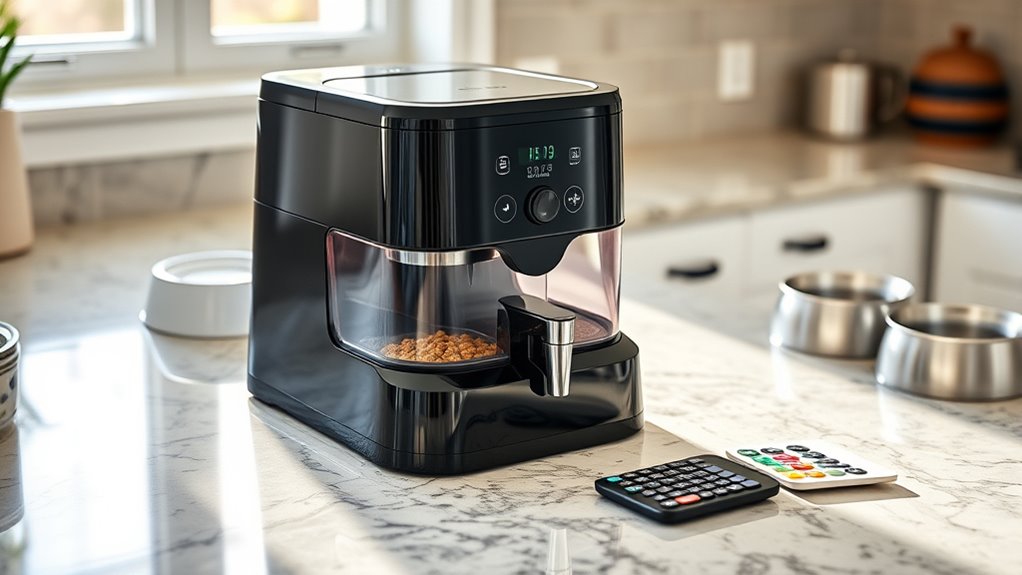
Understanding the cost factors involved in purchasing an automatic pet feeder is crucial for making an informed investment. You should start with a thorough price comparison across different models to find options that fit your budget while offering necessary features. Keep in mind that the initial setup costs can vary; some feeders require additional accessories or installation efforts, which might add to your expenses. Higher-end models often come with advanced features like Wi-Fi connectivity or multiple feeding options, but they also come with a higher price tag. Consider your specific needs and long-term savings—more affordable units might lack durability or essential functions, leading to future replacements or repairs. By evaluating these factors carefully, you’ll make smarter choices aligned with your budget and your pet’s needs.
Impact on Pet Behavior and Socialization
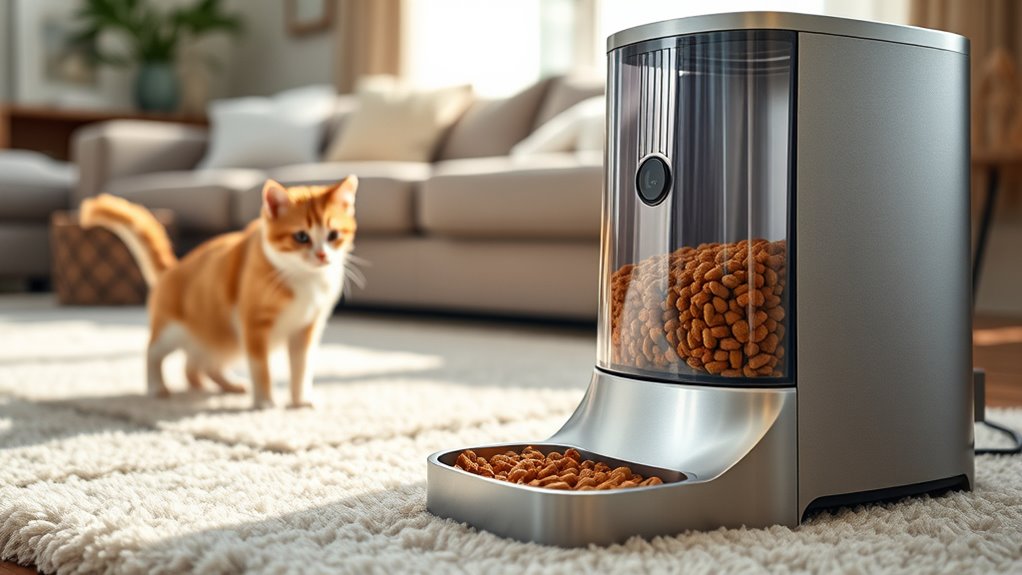
Automatic pet feeders can substantially influence your pet’s behavior and social interactions. They may alter your pet’s social behavior and pet interaction patterns, sometimes leading to unexpected changes. Here are four key effects to contemplate:
- Reduced hunger-driven aggression during meal times.
- Improved routine stability, encouraging consistent social behavior.
- Potential for decreased pet interaction, as pets rely on scheduled feeding.
- Possible social hierarchy shifts if multiple pets share the feeder.
While automatic feeders promote independence, they can also cause pets to become less engaged with their environment or other animals. Understanding these impacts helps you manage your pet’s social behavior effectively, ensuring the technology benefits rather than hinders their socialization and overall well-being.
Maintenance and Cleaning Requirements

Regular maintenance and cleaning are essential to keep your pet feeder functioning properly and to prevent health risks. You should establish a consistent cleaning frequency, such as weekly, to prevent mold, bacteria, and food buildup. Follow simple maintenance routines, like disassembling parts carefully and washing them with warm, soapy water. Check for any blockages or wear and tear that could affect operation. Keep the food storage area dry and free of debris. Regular cleaning not only prolongs the lifespan of your device but also ensures your pet’s health. Be diligent about inspecting the feeder’s components and cleaning them thoroughly, especially after periods of non-use. Staying on top of maintenance routines guarantees your pet feeder remains safe, hygienic, and reliable.
Frequently Asked Questions
How Do Automatic Feeders Handle Pets With Special Dietary Needs?
When it comes to pets with special dietary needs, automatic feeders offer significant benefits. They provide dietary customization, allowing you to program specific portions and types of food suited to your pet’s requirements. You gain feeding flexibility because you can schedule multiple meals or adjust portions easily. Just make certain the feeder supports these features and allows for precise control, so your pet receives the right nutrition consistently.
Are There Safety Features to Prevent Overfeeding or Underfeeding?
You might wonder if automatic feeders have safety features like portion control or a feeding schedule to prevent overfeeding or underfeeding. Many models include portion control settings, so you can set precise amounts, and a feeding schedule guarantees your pet gets fed at consistent times. Some also have alarms or alerts if the food runs low, giving you peace of mind that your pet’s diet remains balanced and safe.
Can Automatic Feeders Accommodate Multiple Pets With Different Diets?
You can manage multiple pets with an automatic feeder by choosing models that support diet customization for each animal. These feeders often have separate compartments or programmable settings, making it easier to guarantee each pet gets the right amount of food and specific dietary needs. This is perfect for multiple pet management, helping prevent conflicts and ensuring each pet maintains a healthy diet without the hassle of manual feeding.
What Backup Options Exist During Power Outages or Technical Failures?
Power problems pose potential pitfalls for automatic feeders. To keep pets fed, you can consider handy backup options like battery backups, ensuring the feeder functions during power outages. Additionally, you should have manual feeding methods ready, allowing you to personally provide meals when needed. By prepping with these practical points, you prevent problems, provide peace of mind, and keep your pets properly nourished, no matter the technical or power troubles.
How Do Automatic Feeders Impact a Pet’S Natural Hunting and Foraging Instincts?
You might wonder how automatic feeders affect your pet’s hunting instincts and foraging behavior. These devices often provide scheduled, predictable meals, which can reduce your pet’s natural drive to hunt or forage for food. Over time, this can diminish their instinctual behaviors, possibly leading to boredom or frustration. To keep their instincts sharp, consider incorporating play and foraging activities into their routine, even with automatic feeding systems in place.
Conclusion
Automatic pet feeders can make your life easier, offering convenience, precise portion control, and accessibility for busy schedules. However, keep in mind potential technical issues and maintenance needs. Did you know that 60% of pet owners report feeding problems with automatic feeders at least once? Weigh the benefits against the costs and possible impacts on your pet’s behavior. With proper care, these feeders can be a great tool for keeping your furry friend happy and well-fed.
